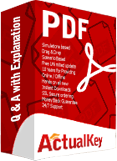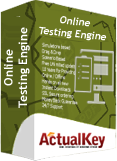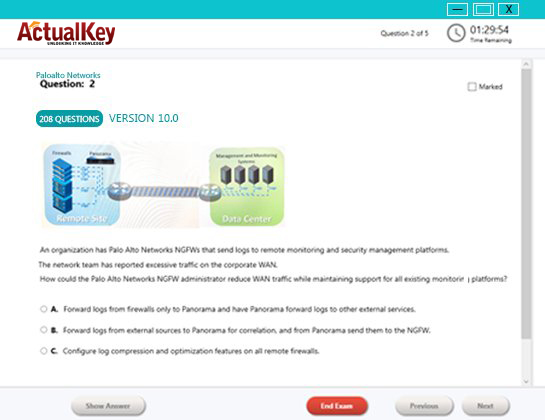Limited Time 30% Discount Offer Use Code - off30
Actualkey Prepration Latest 300-207 : Implementing Cisco Threat Control Solutions (SITCS) Questions and Answers PDF's, Verified Answers via Experts - Pass Your Exam For Sure and instant Downloads - "Money Back Guarantee".
| Vendor | Cisco |
| Certification | CCNP Security |
| Exam Code | 300-207 |
| Title | Implementing Cisco Threat Control Solutions (SITCS) |
| No Of Questions | 242 |
| Last Updated | January 15,2024 |
| Product Type | Q & A with Explanation |
| Bundel Pack Included | PDF + Offline / Andriod Testing Engine and Simulator |
300-207 SITCS
Implementing Cisco Threat Control Solutions
Exam Number 300-207 SITCS
Associated Certifications CCNP Security
Duration 90 minutes (65 - 75 questions)
Available Languages English
The Implementing Cisco Threat Control Solutions (SITCS) (300-207) exam tests a network security engineer on advanced firewall architecture and configuration with the Cisco next-generation firewall, utilizing access and identity policies. This 90-minute exam consists of 65-75 questions and covers integration of Intrusion Prevention System (IPS) and context-aware firewall components, as well as Web (Cloud) and Email Security solutions. Candidates can prepare for this exam by taking the Implementing Cisco Threat Control Solutions (SITCS) course.
Exam Topics
The exam is closed book, and no outside reference materials are allowed. The following topics are general guidelines for the content that is likely to be included on the exam. However, other related topics may also appear on any specific delivery of the exam. In order to better reflect the contents of the exam and for clarity purposes, the guidelines that follow may change at any time without notice.
22% 1.0 Content Security
1.1 Cisco ASA 5500-X NGFW Security Services
1.1.a Describe features and functionality
1.1.b Implement web usage control (URL-filtering, reputation based, file filtering)
1.1.c Implement AVC
1.1.d Implement decryption policies
1.1.e Describe traffic redirection and capture methods
1.2 Cisco Cloud Web Security
1.2.a Describe features and functionality
1.2.b Implement IOS and ASA connectors
1.2.c Implement AnyConnect web security module
1.2.d Describe web usage control
1.2.e Implement AVC
1.2.f Implement anti-malware
1.2.g Describe decryption policies
1.3 Cisco WSA
1.3.a Describe features and functionality
1.3.b Implement data security
1.3.c Implement WSA Identity and Authentication, including
Transparent User Identification
1.3.d Describe web usage control
1.3.e Implement AVC
1.3.f Implement anti-malware
1.3.g Describe decryption policies
1.3.h Describe traffic redirection and capture methods (Explicit Proxy vs. Transparent Proxy)
1.4 Cisco ESA
1.4.a Describe features and functionality
1.4.b Implement email encryption
1.4.c Implement anti-spam policies
1.4.d Implement virus outbreak filter
1.4.e Implement DLP policies
1.4.f Implement anti-malware
1.4.g Implement inbound and outbound mail policies and authentication
1.4.h Describe traffic redirection and capture methods
23% 2.0 Threat Defense Collapse
2.1 Network IPS
2.1.a Implement traffic redirection and capture methods
2.1.b Implement network IPS deployment modes
2.1.c Describe signatures engines
2.1.d Implement event actions & overrides/filters
2.1.e Implement anomaly detection
2.1.f Implement risk ratings
2.1.g Describe IOS IPS
2.2 Configure device hardening per best practices
2.2.a IPS
2.2.b Content Security appliances
16% 3.0 Devices GUIs and Secured CLI Collapse
3.1 Content Security
3.1.a Implement HTTPS and SSH access
3.1.b Describe configuration elements
3.1.c Implement ESA GUI for message tracking
19% 4.0 Troubleshooting, Monitoring and Reporting Tools
4.1 Configure IME and IP logging for IPS
4.2 Content Security
4.2.a Describe reporting functionality
4.2.b Implement the WSA Policy Trace tool
4.2.c Implement the ESA Message Tracking tool
4.2.d Implement the ESA Trace tool
4.2.e Use web interface to verify traffic is being redirected to CWS
4.2.f Use CLI on IOS to verify CWS operations
4.2.g Use CLI on ASA to verify CWS operations
4.2.h Use the PRSM Event Viewer to verify ASA NGFW operations
4.2.i Describe the PRSM Dashboards and Reports
4.3 Monitor Cisco Security IntelliShield
4.3.a Describe at a high level the features of the Cisco Security IntelliShield Alert Manager Service
8% 5.0 Threat Defense Architectures Collapse
5.1 Design IPS solution
5.1.a Deploy Inline or Promiscuous
5.1.b Deploy as IPS appliance, IPS software or hardware module
or IOS IPS
5.1.c Describe methods of IPS appliance load-balancing
5.1.d Describe the need for Traffic Symmetry
5.1.e Inline modes comparison - inline interface pair, inline VLAN pair, and inline VLAN group
5.1.f Management options
12% 6.0 Content Security Architectures Collapse
6.1 Design Web Security solution
6.1.a Compare ASA NGFW vs. WSA vs. CWS
6.1.b Compare Physical WSA vs. Virtual WSA
6.1.c List available CWS connectors
6.2 Design Email Security solution
6.2.a Compare Physical ESA vs. Virtual ESA
6.2.b Describe Hybrid mode
6.3 Design Application Security solution
6.3.a Describe the need for application visibility and control
I Got My Success Due To Actualkey 300-207 Bundle Pack Actualkey experts I got passed in the 300-207 exam without any worries at all, these exam material products gave me the reason to relax.
Budi Saptarmat
Yahoo! Got Successfully Through The 300-207 Exam Passing Exam is not a easy thanks to Acutalkey.com for providing me actual 300-207 Implementing Cisco Threat Control Solutions (SITCS) training with there included the Offline and Android simulators helps me success
Melinda
300-207 Exam Best Preparation I have been preparing for 300-207 Implementing Cisco Threat Control Solutions (SITCS), I was not sure that I'll be able to pass because of the fact that I am not a good student however;Actualkey.com provided me best and simple exam training pdf's and I passed. I now recommend everyone
Antonio Moreno
Actualkey.com 300-207 Offline Simulator is Best My choice to select Actualkey.com and go for the preparation 300-207 Implementing Cisco Threat Control Solutions (SITCS), because I got the short way with the easy way
Liliane Meichner
Actualkey.com 300-207 Exam PDF"s passed with in a week 300-207 exam pdf's that's amazing
James Wilson
Cisco - RELATED EXAMS
Implementing Cisco Unified Communications Manager Part 2 (CIPT2 v6.0)
Questions: 174 | May 8, 2024
Implementing Cisco Security Monitoring, Analysis andResponse System
Questions: 49 | May 8, 2024
Cisco Wide Area Application Services for System Engineers exam
Questions: 60 | August 1, 2024
Cisco Data Center Networking Infrastructure Solutions design
Questions: 120 | August 1, 2024
Implementing Cisco Unified Wireless Networking Essentials (IUWNE)
Questions: 203 | July 1, 2024
Associated Certifications: Cisco Storage Networking Support Specialist
Questions: 74 | August 1, 2024
Implementing Cisco Security Monitoring, Analysis, and Response System
Questions: 67 | August 1, 2024
Wide Area Application Services for System Engineers (WAASSE)
Questions: 90 | January 5, 2024
Implementing Advanced Cisco Unified Wireless Security (IAUWS)
Questions: 85 | January 7, 2024
Troubleshooting and Maintaining Cisco IP Switched Networks (TSHOOT)
Questions: 72 | January 7, 2024
Implementing Cisco Unified Communications Voice over IP and QoS v8.0 (CVOICE v8.0)
Questions: 257 | July 1, 2024
Securing Networks with Cisco Routers and Switches (SECURE) v1.0
Questions: 136 | July 1, 2024
Implementing Cisco Unified CommunicationsManager, Part 2 v8.0 (CIPT2 v8.0)
Questions: 215 | July 1, 2024
Introducing Cisco Voice and Unified Communications Administration v8.0
Questions: 300 | May 8, 2024
Integrating Cisco Unified Communications Applications v8.0 (CAPPS v8.0)
Questions: 203 | May 8, 2024
Operational Foundations for Cisco Service Provider Core Networks
Questions: 91 | May 8, 2024
Maintaining Cisco Service Provider VPNs and MPLS Networks (MSPVM)
Questions: 89 | May 8, 2024
Cisco Data Center Unified Computing Support Specialist Qualifier Exam (DCUCI Qualifier Exam)
Questions: 65 | May 8, 2024
Cisco Data Center Unified Computing Design Specialist Qualifier Exam
Questions: 62 | May 8, 2024
Designing for Cisco Internetwork Solutions Exam (DESGN) v2.1
Questions: 241 | October 1, 2024
Maintaining Cisco Service Provider Routing Protocols (MSPRP)
Questions: 70 | October 1, 2024
Maintaining Cisco Service Provider Quality of Service (MSPQS)
Questions: 91 | October 1, 2024
PSACAS Advanced Collaboration Architecture Sales Specialist Exam
Questions: 56 | May 8, 2024
PSACASE Advanced Collaboration Architecture System Engineer Exam
Questions: 64 | May 8, 2024
PSACAFE Advanced Collaboration Architecture Field Engineer Exam
Questions: 50 | August 1, 2024
Cisco IronPort Certified Security Professional (CICSP) Web Security 7.0
Questions: 66 | August 1, 2024
Implementing Cisco TelePresence Video Networking Solutions Exam
Questions: 57 | August 1, 2024
Advanced Borderless Network Architecture Systems Engineer Exam
Questions: 60 | August 1, 2024
Cisco Substation Automation System and Field Engineer Knowledge Verification
Questions: 58 | May 8, 2024
Authorized Connected Grid Account Manager Knowledge Verification
Questions: 23 | August 1, 2024
Cisco Data Center Unified Computing Systems Implementation (DCUCI)
Questions: 78 | May 8, 2024
Introduction to 802.1X Operations for Cisco Security Professionals Exam (S802DT1X)
Questions: 69 | May 8, 2024
Introducing Cisco Identity Services Engine for System Engineer Exam (PAISESE)
Questions: 34 | May 8, 2024
PASCERAM - Cisco SaaS Conferencing and EIM Resale ATP for the AM Exam
Questions: 35 | May 8, 2024
Cisco SP Video Wireline & Cable Headend Design Specialist for SE
Questions: 33 | May 8, 2024
PASCERSE - Cisco SaaS Conferencing and EIM Resale ATP for the SE Exam
Questions: 56 | May 8, 2024
Building Cisco Service Provider Next-Generation Networks, Part 2
Questions: 126 | May 8, 2024
Building Cisco Service Provider Next-Generation Networks, Part 1 Exam
Questions: 257 | October 25, 2024
Implementing Advanced Cisco Unified Wireless Security (IAUWS) v2.0
Questions: 206 | May 8, 2024
Deploying Cisco Service Provider Network Routing (SPROUTE)
Questions: 174 | January 12, 2024
Implementing Cisco Service Provider Next-Generation Core Network Services (SPCORE)
Questions: 184 | January 12, 2024
Implementing Cisco Service Provider Next-Generation Edge Network Services (SPEDGE) Exam
Questions: 185 | January 12, 2024
Implementing and Maintaining Cisco Technologies Using IOS XR - (IMTXR)
Questions: 77 | January 12, 2024
Designing and Implementing Cisco Unified Communications on Unified Computing Systems - DIUCUCS
Questions: 60 | January 12, 2024
Implementing and Configuring Cisco Identity Service Engine - SISE
Questions: 49 | July 1, 2024
PASCERFE - Cisco SaaS Conferencing and EIM Resale ATP for the FE Exam
Questions: 53 | July 1, 2024
Advanced Borderless Network Architecture Field Engineer Exam
Questions: 86 | January 15, 2024
Advanced Borderless Network Architecture Systems Engineer Exam (700-303)
Questions: 156 | January 15, 2024
Cisco Implementing Cisco Secure Mobility Solutions Exam (SIMOS)
Questions: 543 | May 17, 2024
Unified Communications Contact Center Express Implementation - UCCX
Questions: 50 | January 15, 2024
Performing Business-Focused Transformative Architecture Engagements
Questions: 67 | January 17, 2024
Configuring Cisco UCS and Cisco Catalyst 3000 for Vblock Series 100
Questions: 45 | January 17, 2024
Cisco Application Centric Infrastructure for System Engineers
Questions: 58 | January 17, 2024
Implementing Cisco Service Provider Mobile Unlicensed Small Cell Solutions
Questions: 51 | January 17, 2024
Securing Cisco Networks with Sourcefire Intrusion Prevention System
Questions: 59 | January 17, 2024
Implementing Cisco Service Provider Mobility UMTS Networks (SPUMTS)
Questions: 70 | January 17, 2024
Implementing Cisco Service Provider Mobility CDMA Networks (SPCDMA)
Questions: 70 | January 17, 2024
Implementing Cisco Service Provider Mobility LTE Networks (SPLTE)
Questions: 70 | January 17, 2024
Integrating Business Applications with Network Programmability (NPIBA)
Questions: 66 | January 17, 2024
Managing Industrial Networks with Cisco Networking Technologies (IMINS)
Questions: 64 | January 17, 2024
Designing with Cisco Network Programmability for ACI (NPDESACI)
Questions: 60 | January 17, 2024
Implementing with Cisco Network Programmability for ACI (NPENGACI)
Questions: 60 | January 17, 2024
Cisco Application Centric Infrastructure for Account Managers
Questions: 41 | January 17, 2024
Executing Cisco Advanced Business Value Analysis and Design Techniques
Questions: 60 | July 1, 2024
Troubleshooting and Maintaining Cisco IP Networks (TSHOOT)
Questions: 254/24Case Study | January 18, 2024
Cisco Application Centric Infrastructure for Field Engineers Exam
Questions: 50 | September 16, 2024
Implementing and Supporting Cisco Unified Contact Center Enterprise Exam
Questions: 95 | September 16, 2024
Executing Cisco Advanced Business Value Analysis and Design Techniques
Questions: 182 | September 16, 2024
Applying Cisco Specialized Business Value Analysis Skills
Questions: 173 | September 16, 2024
Cisco Implementing Cisco Wireless Network Fundamentals Exam
Questions: 509 | September 16, 2024
Managing Industrial Networks for Manufacturing with Cisco Technologies
Questions: 87 | September 16, 2024
Cisco Implementing and Troubleshooting the Cisco Cloud Infrastructure Exam
Questions: 132 | September 16, 2024
Building the Cisco Cloud with Application Centric Infrastructure
Questions: 60 | September 16, 2024
Cisco Leading Virtual Classroom Instruction - Written Exam
Questions: coming soon | September 16, 2024
Cisco Leading Virtual Classroom Instruction - Practical Exam
Questions: coming soon | September 16, 2024
Integrating Business Applications with Network Programmability
Questions: coming soon | January 19, 2024
Cisco Implementing Cisco Data Center Virtualization and Automation Exam
Questions: 167 | January 21, 2024
Cisco Midsize Collaboration Solutions for Account Managers (MCAM)
Questions: 30 | April 11, 2024
Cisco Data Center Unified Computing Infrastructure Design (DCICUC)
Questions: 40 | January 21, 2024
Cisco Enterprise Networks SDA, SDWAN and ISE Exam for System Engineers
Questions: 35 | January 21, 2024
Automating and Programming Cisco Security Solutions (SAUTO) Exam
Questions: 332 | May 9, 2024
Implementing and Operating Cisco Enterprise Network Core Technologies (ENCOR) Exam
Questions: 1213 | April 12, 2025
Implementing and Operating Cisco Data Center Core Technologies (DCCOR) Exam
Questions: 669 | June 4, 2025
Implementing Cisco Enterprise Advanced Routing and Services (ENARSI) Exam
Questions: 615 | March 14, 2025
Understanding Cisco Cybersecurity Operations Fundamentals (CBROPS) Exam
Questions: 430 | May 9, 2024
Designing Cisco Enterprise Wireless Networks (300-425 ENWLSD) Exam
Questions: 196 | November 8, 2024
Implementing Cisco Enterprise Wireless Networks (300-430 ENWLSI) Exam
Questions: 216 | November 8, 2024
Automating and Programming Cisco Enterprise Solutions (ENAUTO 300-435) Exam
Questions: 125 | November 8, 2024
Designing Cisco Data Center Infrastructure (300-610 DCID) Exam
Questions: 258 | April 15, 2025
Troubleshooting Cisco Data Center Infrastructure (300-615 DCIT) Exam
Questions: 517 | November 8, 2024
Implementing Cisco Application Centric Infrastructure (300-620 DCACI) Exam
Questions: 247 | May 22, 2025
Implementing Cisco Storage Area Networking (300-625 DCSAN) Exam
Questions: 60 | November 8, 2024
Implementing and Configuring Cisco Identity Services Engine (300-715 SISE) Exam
Questions: 244 | November 8, 2024
Securing Email with Cisco Email Security Appliance (300-720 SESA) Exam
Questions: 147 | November 8, 2024
Securing the Web with Cisco Web Security Appliance (300-725 SWSA) Exam
Questions: 60 | November 8, 2024
Implementing Secure Solutions with Virtual Private Networks (SVPN 300-730) Exam
Questions: 175 | November 8, 2024
Implementing Cisco Collaboration Applications (300-810 CLICA) Exam
Questions: 213 | November 8, 2024
Implementing Cisco Advanced Call Control and Mobility Services (300-815 CLACCM) Exam
Questions: 221 | May 22, 2025
Implementing Cisco Collaboration Cloud and Edge Solutions (300-820 CLCEI)
Questions: 207 | August 3, 2025
Implementing DevOps Solutions and Practices using Cisco Platforms (300-910 DEVOPS) Exam
Questions: 130 | November 8, 2024
Developing Applications for Cisco Webex and Webex Devices (300-920 DEVWBX) Exam
Questions: 60 | November 8, 2024
Implementing and Operating Cisco Service Provider Network Core Technologies (350-501 SPCOR)
Questions: 452 | November 8, 2024
Implementing and Operating Cisco Security Core Technologies (SCOR 350-701) Exam
Questions: 689 | June 5, 2025
Implementing Cisco Collaboration Core Technologies (350-801 CLCOR) Exam
Questions: 361 | August 3, 2025
Developing Applications using Cisco Core Platforms and APIs v1.0 (DEVCOR 350-901) Exam
Questions: 363 | November 8, 2024
Designing Cisco Unified Contact Center Enterprise (UCCED) Exam
Questions: 93 | November 8, 2024
Implementing Cisco Application Centric Infrastructure - Advanced (600-660 - 300-630 DCACIA)
Questions: 76 | November 8, 2024
Supporting Cisco Routing and Switching Network Devices v3.0 - RSTECH Exam
Questions: 72 | November 8, 2024
Cisco Security Architecture for System Engineers (ASASE) Exam
Questions: 92 | November 8, 2024
Implementing Cisco Service Provider Advanced Routing Solutions (SPRI) Exam
Questions: 269 | April 12, 2025
Implementing Cisco Service Provider VPN Services (300-515 SPVI) Exam
Questions: 71 | November 8, 2024
Developing Solutions Using Cisco IoT and Edge Platforms (DEVIOT) Exam
Questions: 60 | November 8, 2024
Conducting Forensic Analysis and Incident Response Using Cisco CyberOps Technologies (CBRFIR) Exam
Questions: 59 | May 10, 2024
Performing CyberOps Using Core Security Technologies (CBRCOR) Exam
Questions: 139 | May 10, 2024
Implementing Cisco Collaboration Conferencing (CLCNF) Exam
Questions: 60 | September 16, 2024
Implementing Cisco SD-WAN Solutions (ENSDWI) Exam Corresponding Certification: CCNP Enterprise
Questions: 163 | September 16, 2024
Cisco Data Center Unified Computing Infrastructure Troubleshooting Exam
Questions: 40 | September 16, 2024
ENCOR Implementing and Operating Cisco Enterprise Network Core Technologies
Questions: 747 | May 10, 2024
Cisco Advanced Administration and Reporting of Contact Center Enterprise Exam
Questions: 60 | July 1, 2024
Cisco Certified Support Technician (CCST) Networking Exam
Questions: 40 | November 7, 2024
Cisco Collaboration SaaS Authorization for PreSales Engineer Exam
Questions: 60 | September 4, 2024
Implementing Cisco Application Centric Infrastructure - Advanced Exam
Questions: 119 | April 4, 2025
Designing and Implementing Secure Cloud Access for Users and Endpoints Exam
Questions: 61 | July 29, 2025
Cisco Certified Support Technician (CCST) Cybersecurity Exam
Questions: 50 | August 16, 2025
Exams code, certifications, vendor or keywords
![]()
Copyright © 2009 - 2025 Actualkey. All rights reserved.





